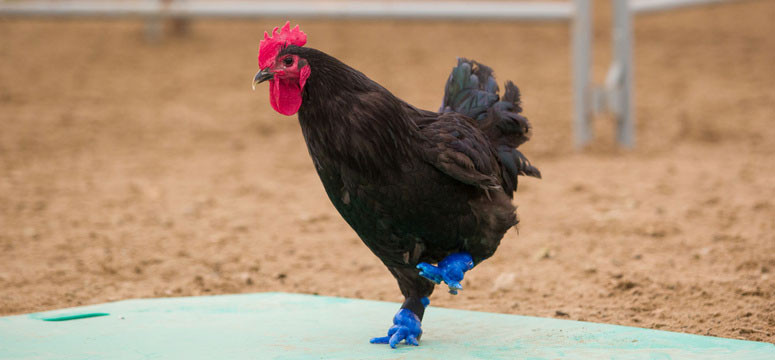
U of C researchers fit rooster with 3D printed feet
By Claudia Wong, July 23 2015 —
Researchers at the University of Calgary have fitted a rooster with 3D printed prosthetics. Foghorn the rooster was picked up last winter by Calgary Animal and Bylaw Services after losing his feet to frostbite.
After being fitted with prosthetic feet by professor of veterinary medicine Daniel Pang, researcher Mark Ungrin and summer research student Douglas Kondro, Foghorn can now successfully walk again.
Kondro is an undergraduate mechanical engineering student at the U of C who specializes in biomedical engineering. His usual summer research involves creating practice simulators for surgeons.
“It was pretty neat to work on a project from start to finish and also neat to apply 3D printing skills to a project,” Kondro said.
The researchers used scans of turkey feet in the first trial, but they turned out to be too rigid.
“I assumed he walked like us, as in straight up and down. He was leaning too far on his feet and couldn’t walk. They actually walk at a 45 degree angle,” Kondro said.
The researchers were successful the second time. With the use of PLA plastic and other materials, Foghorn was able to walk once the second set of feet were strapped to him.
“The PLA plastic was used for the skeleton of the foot and I painted on silicone,” Kondro said.
The team plans to examine the feet in the future to see if they can withstand use in Canada’s harsh climate.
“We’re going to do a follow-up to see if the feet work for him. I designed the feet to be as durable as possible so they can be used in the winter,” Kondro said.
Kondro believes 3D printing could one day be applied to dynamic body parts like bone joints or even skin, although he added that a great deal of research is required before that happens.
Kondro cited the 3D printing of a trachea by doctors in New York in 2014 as an example of what can be achieved. The trachea was printed using completely biological material, with an end goal of implanting it into a patient and allowing the trachea to grow. Kondro said things get more complicated when you start using human tissue.
“If you get a kidney transplant — because of the antigens it’s viewed as a foreign object,” Kondro said. “This is a problem with transplants right now.”
Since getting his new feet, Foghorn was adopted and is currently living on an acreage near Olds.
